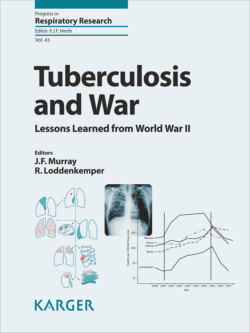Читать книгу Tuberculosis and War - Группа авторов - Страница 45
На сайте Литреса книга снята с продажи.
Abstract
ОглавлениеDuring wartime, in most cases, both environmental and host factors are likely to be co-responsible for commonly observed increases in tuberculosis (TB). The 2 most important risk factors are indoor overcrowding, which increases the risk of transmission, and malnutrition, which weakens the immune defenses of the host. Together, these and other factors increase the prevalence of latent infection and the subsequent risk of progression to active disease, respectively, thereby resulting in an increase in morbidity, and in consequence also mortality. As a result of this increased morbidity, transmission is likely to increase further because of the excess prevalence of transmissible TB and the greater opportunity for person-to-person spread due to overcrowding. In this chapter, multiple factors will be analyzed that may explain the variations observed in different countries. In addition, various TB control measures are addressed which existed before the war and which evolved during and after World War II as a response to the deterioration of the TB situation.
© 2018 S. Karger AG, Basel
World War II (WWII) involved almost the whole world. With an estimated more than 50 million fatalities in both military and civilian populations, it was the deadliest conflict in human history. According to Daniels [1, 2], tuberculosis (TB) was the major health disaster of this war; he emphasized that “the number of additional deaths from TB during the war must run into many hundreds of thousands, and the number of surviving sufferers must number between 5 and 10 million.” All countries – both Axis and Allies – were affected by TB as a consequence of the war, albeit with distinctly different patterns as outlined in chapter 1: countries in which there was little or no wartime rise; countries in which the mortality rate rose in the first years and fell in the later years of the war; and countries in which death rates rose throughout the war years to a peak at the end of the war [3, 4]. Even non-belligerent countries observed an increase in TB, whereas only a few belligerent countries saw a fall in the numbers of TB cases (Bulgaria, Denmark, and England and Wales) [5].
As discussed in chapter 2, several problems impede the retrieval of reliable epidemiological data during wartime. They include destruction of public health infrastructure, redeployment, transfer or elimination of health resources and personnel, collapse of communication systems, lack of diagnostic capabilities and also censorship, propaganda, and the intentional falsification of information [5]. However, it is likely that at least the observed trends delineated in detail in chapters 5–19 are germane and plausible.
In this chapter, factors that may explain the variations observed in the situation from one country to another during wartime will be analyzed. Both environmental and host-dependent factors that may increase the risk of infection with tubercle bacilli and the risk of progression from latent TB infection to overt clinical TB and finally to death from the disease will be discussed. During wartime, in most cases, both environmental and host factors are likely to be responsible; of these, the 2 most important ones are: first, overcrowding in small dwellings, which increases the risk of transmission through the inhalation of Mycobacterium tuberculosis (M. tuberculosis) containing droplet nuclei, and second, malnutrition, which weakens the immune defenses of the host. Together, these factors increase the risk of progression to active disease among the prevalent latently infected individuals, thereby resulting in a short-term increase in morbidity and mortality. In addition, environmental transmission increases because of the higher prevalence of active disease and greater opportunity for person-to-person spread due to overcrowding. New infections resulting from this increase in community transmission may develop into cases of active disease, months or years later [6].
